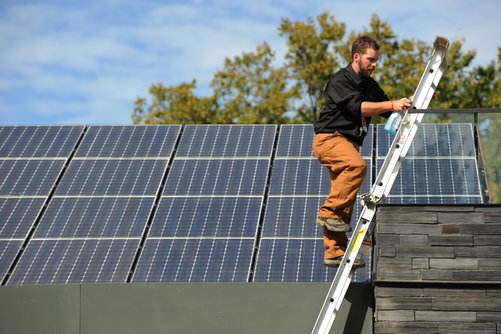
The company’s latest report finds that under current policies residential solar will reach grid parity in 42 states by 2020, but expects policy changes to undermine these economics.
Grid parity – the point when generation from solar PV is cheaper than retail electricity – is widely accepted as the point when distributed solar beats centralized generation on economics, regardless of other benefits. And while this for years was held as a far-away “Holy Grail”, a new report by GTM Research finds that residential solar has already hit grid parity in 20 U.S. states.
California, Hawaii and Massachusetts currently lead in terms of economic benefits of solar, which is likely a factor in these states’ leadership in residential solar penetration levels. The report further finds that given rising electricity prices and falling PV system prices, the cost of electricity from residential solar will fall below grid parity in another 22 states by 2020 under business-as-usual conditions.
Unlike many estimates of grid parity which rely on average retail rates, GTM Research’s U.S. Residential Solar Economic Output looks at state and utility-specific rate design to determine the relationship of electricity from PV to retail. A second finding of the report is that rate design and net metering policies are primary determinants of when solar reaches grid parity.
“To date, the residential solar market’s growth has primarily come from a handful of states where favorable rate structures and net metering rules have set high, predictable ceilings on savings due to solar,” says GTM Research Solar Analyst Cory Honeyman, lead author of the report.
“But with more and more utilities reevaluating net metering rules and rate design, the residential solar economic outlook can no longer depend on a static policy landscape that fueled the nearly 1 million homeowners now with rooftop solar. Looking ahead, it is no longer a question of if, but rather, when and to what extent rate structures and net metering rules are revised.”
The raw cost of retail electricity is also a factor; California, Hawaii and Massachusetts have some of the highest retail electricity rates in the nation.
In the report, GTM Research looks at several scenarios for changes to renumeration under net metering, including new monthly fixed and demand charges and reduced valuations for the electricity from PV, all of which have been implemented as part of changes to net metering polices in multiple states.
The report found that if all states were to implement a $50 fixed monthly charge to net metering installations, that residential solar would be at grid parity in only two states. The impact from a 50% reduction in the value of electricity exported to the grid would be less severe, and residential solar would still be at grid parity in 10-15 states.
Source: PV Magazine. Reproduced with permission.









